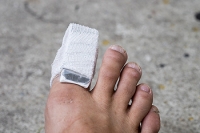Patients who have broken their toes generally understand the importance of refraining from putting pressure on the injured toe. This can be difficult while attempting to perform cardiovascular exercises. Regular routines may have to be substituted with movements that have little to no impact. These can include using rowing and elliptical machines, in addition to swimming and bicycling. If the fracture is minor, buddy taping may be an effective method in providing the stability that is necessary as the healing process occurs. It may also be beneficial to wear shoes that are wider in the toe area, as this may help to manage existing pain. If you have broken your toe, and would like additional information about how to perform exercises, it is advised that you seek the counsel of a podiatrist.
Broken toes may cause a lot of pain and should be treated as soon as possible. If you have any concerns about your feet, contact Dr. Kenneth Donovan from Advanced Care Foot and Ankle. Our doctor will treat your foot and ankle needs.
What Is a Broken Toe?
A broken toe occurs when one or more of the toe bones of the foot are broken after an injury. Injuries such as stubbing your toe or dropping a heavy object on it may cause a toe fracture.
Symptoms of a Broken Toe
- Swelling
- Pain (with/without wearing shoes)
- Stiffness
- Nail Injury
Although the injured toe should be monitored daily, it is especially important to have a podiatrist look at your toe if you have severe symptoms. Some of these symptoms include worsening or new pain that is not relieved with medication, sores, redness, or open wounds near the toe.
If you have any questions, please feel free to contact one of our offices located in Warren, Livingston, and Toms River, NJ . We offer the newest diagnostic and treatment technologies for all your foot care needs.

